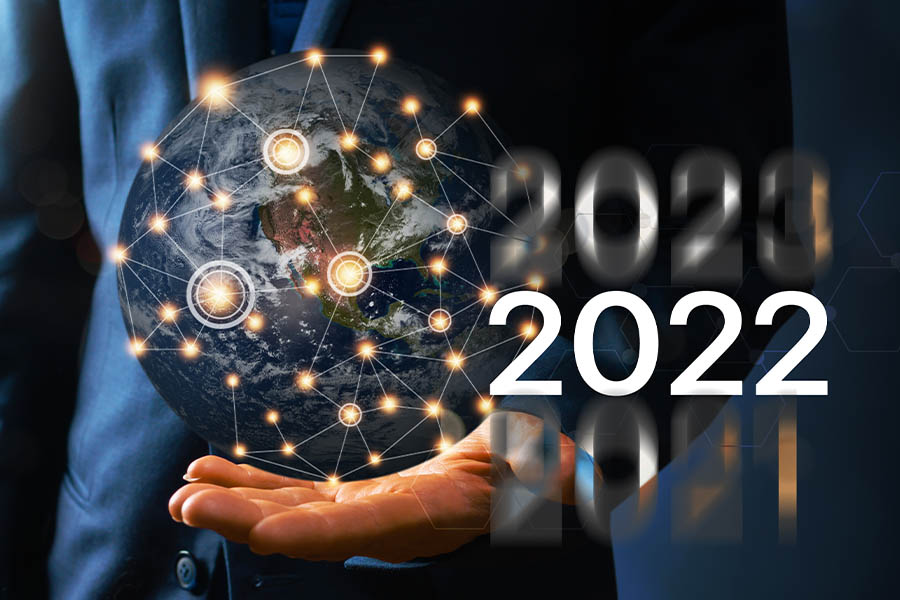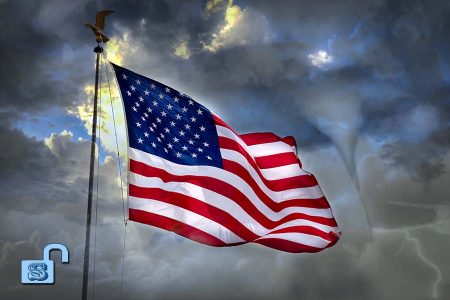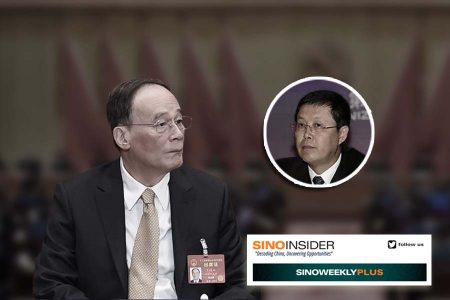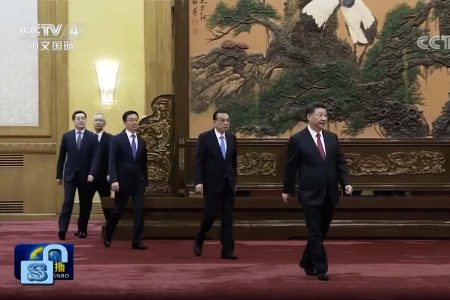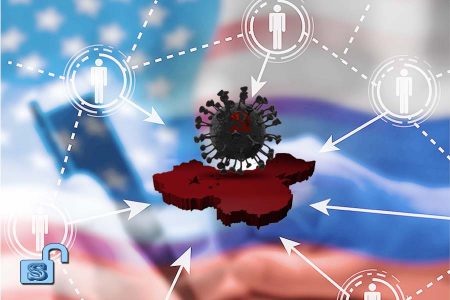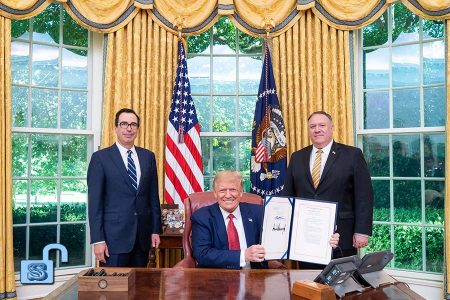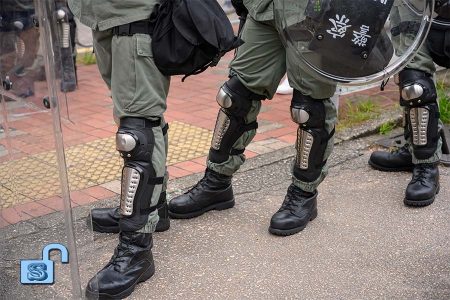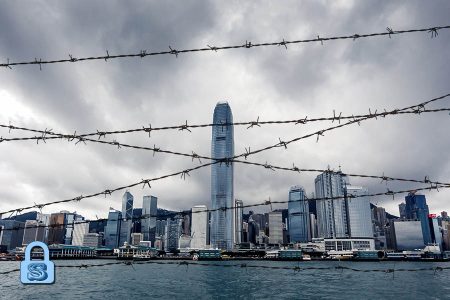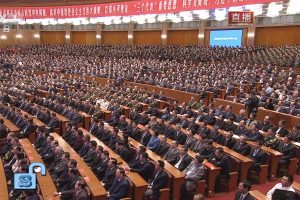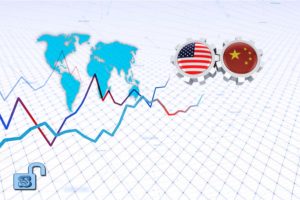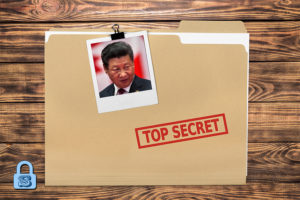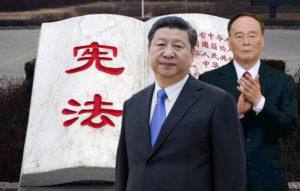◎ We made 41 predictions covering eight topics in our China 2022 Outlook. Thirty-eight of those 41 predictions were verified over the year, giving us a forecasting accuracy of 92.7 percent.
The early half of the year saw escalated factional struggle tensions in the Party elite, particularly with the publication of an article on a PRC-sponsored overseas Chinese language internet forum that was highly critical of Xi Jinping in January. Xi, however, struck back against his factional foes over the course of the year with a wave of purges (particularly in the political and legal affairs apparatus and the financial sector) and successfully centralized power to an even greater degree at the 20th Party Congress.
Meanwhile, Xi sticking to “zero-COVID” for most of the year appeared to sharply worsen the PRC’s internal and external problems. Social tensions boiled over near the end of the year with the “white paper revolution” and workers escaping factory campuses under lockdown, forcing Beijing to abruptly abandon the “zero-COVID” policy by December 2022. Dismal economic numbers for most of the year, a lackluster recovery in the first half of 2023, and the CCP officially admitting to population decline affirm our earlier assessment.
Some of our key forecasts for 2022 include:
- The emergence of the pro-Jiang faction and anti-Xi article, “An Objective Evaluation of Xi Jinping,” as well as Xinhua’s homepage featuring a picture of Jiang Zemin as a university graduate as the lead photo of his expanded death biography, affirmed our prediction that “factional struggle in the CCP elite will spill out into the open to a greater degree.”
- Xi broke personnel reshuffle norms in appointing of Li Qiang, Zhang Youxia, He Weidong, Li Shulei, Ying Yong, and other allies to key positions, affirming our prediction.
- The CCP authorities sentenced prominent Jiang faction associates Xiao Jianhua, Sun Lijun, and Fu Zhenghua around the Beidaihe period, while the John Lee administration in Hong Kong withdrew from the legislative agenda a national security bill that would see the government enact Article 23 of the Basic Law, affirming our prediction that Xi could make surprising moves to secure a third term.
Politics: 4 predictions, 4 verified
1. Factional struggle in the CCP elite will spill out into the open to a greater degree. This includes the various factions releasing scandals and other “explosive” negative information about each other (in overseas media and social media, etc.), as well as covert and overt efforts by the various factions to attack each other’s negative political legacies. VERIFIED
- January:
Jan. 19: An article titled “An Objective Evaluation of Xi Jinping” (客觀評價習近平) was published on the PRC-sponsored overseas Chinese language internet forum 6park (留園網). Bylined “The Ark and China” (“Fang Zhou and China”; 方舟與中國), the over 42,000 character-long article received attention in both Chinese and English-language media, and was widely commented on by China watchers.***
CCP propaganda media outlets published several commentaries after the 20th Party Congress which hint at Xi Jinping’s displeasure with how the regime was governed by his predecessors. One commentary observed that there were “some shocking corruption issues” (a jibe at Jiang faction’s era of dominance) and “prominent contradictions within the Party.” Meanwhile, Xi is depicted as having “accomplished a lot of long-term and important matters, turned the tide, prevented structural collapse (扶大廈之將傾), and wrote a magnificent chapter of great changes in the great struggle.”
- December:
Dec. 2: Xinhua’s homepage used a picture of Jiang Zemin as a university graduate for the lead photo for his expanded death biography. We analyzed how this appeared to be a deliberate move by the Xi leadership to advance factional struggle goals.
Dec. 16: Qiushi used a photo of Jiang Zemin as a university graduate for the cover photo of the Central Institute of Party History and Literature article commemorating Jiang. “
2. Officials in the political and legal affairs apparatus and financial system will be high-risk targets in Xi’s “rectification” campaigns. Current or retired Party or national-level leaders may even be investigated. VERIFIED
Political and legal affairs apparatus
- February:
Feb. 12: Gao Wanxiang, a Party Committee member and deputy director of the Henan Provincial Public Security Bureau, was investigated.
- March:
March 1: Wang Dawei, vice governor and public security director of Liaoning Province, was investigated.
March 12: Liu Yanping, former head of the discipline inspection and supervision team of the Ministry of State Security, was investigated.March 15: Yang Yaowei, former vice mayor and public security director of Dalian City, was investigated.
March 21: Shen Deyong, a standing committee member of the 13th National Committee of the Chinese People’s Political Consultative Conference, director of the CPPCC Social and Legal Affairs Committee, and former executive vice president of the Supreme People’s Court, was investigated.
- April:
April 9: Zuo Suofen, former deputy Party secretary of the Jiangsu Provincial Public Security Bureau, was investigated.
April 22: Hu Yifeng, former Party secretary and president of the Inner Mongolia Higher People’s Court, was investigated.
- May:
May 10: Liu Cheng, deputy Party secretary of the Hainan Political and Legal Affairs Commission, was investigated.
May 15: Yang Guangming, former deputy Party secretary and public security executive deputy director of Tibet, was investigated.
May 17: Liu Leguo, former Party Committee member of the Liaoning Public Security Bureau, was investigated.
May 28: Cheng Jiandong, former deputy director of the Jiangsu Public Security Bureau, was investigated.
- June:
June 1: Zhang Ben, procurator-general of the Shanghai People’s Procuratorate, was investigated.
June 7: Wang Wei, a Party Committee member and executive deputy director of the Dalian Public Security Bureau, was investigated.
June 15: Zhao Zhigang, Party group deputy secretary and deputy procurator-general of the Jiangsu People’s Procuratorate, was investigated.
June 16: Meng Bing, executive deputy Party secretary of the Liaoning Political and Legal Affairs Commission, was investigated.
- July:
July 5: Xiao Peng, former Party group deputy secretary and deputy procurator-general of the Dalian People’s Procuratorate, was investigated.
- August:
Aug. 5: Liu Jialuo, deputy director of the Liaoning Public Security Bureau, was investigated.
Aug. 8: Cao Jianguo, former Party group deputy secretary and vice president of the Shaanxi Higher People’s Court, was investigated.
Aug. 9: Tang Bin, former deputy Party secretary and deputy director of the Guangxi Public Security Bureau, was investigated.
Aug. 22: Chen Zhong, head of the anti-drug and drug enforcement team of the Sichuan Public Security Bureau, was investigated.
- September:
Sept. 21 – Sept. 23: Six of eight members o
Sept. 26: Chen Zhigang, former Party secretary and director of the Anshan Public Security Bureau, were investigated.
- October:
Oct. 26: Liu Wenxin, deputy Party secretary of the Guizhou Political and Legal Affairs Commission, was investigated.
- November:
Nov. 1: Li Chao, former Party secretary and director of the Panjin, Chaoyang, and Anshan public security bureaus, was investigated.
Nov. 4: Dong Xuefeng, inspector at the Liaoning Public Security Bureau, was investigated.
Nov. 4: Qiu Jin, former vice mayor and public security director of Liaoyang City, was investigated.
Nov. 5: Tao Hui, former Party Committee member and Political and Legal Affairs secretary of Guangxi Province, was investigated.
Nov. 5: Wang Qiaoquan, Party Committee member and deputy president of the Jiangsu Police College, was investigated.
Nov. 6: Zhang Fusheng, Party Committee member and deputy director of the Ministry of Emergency Management’s fire rescue bureau, was investigated.
Nov. 19: Zeng Xianglan, a second-level inspector of the Guangdong Public Security Bureau, was investigated.
- December:
Dec. 8: Xiao Fajun, deputy Party secretary of Qiannan Prefecture in Guizhou Province and Qiannan Political and Legal Affairs Commission Party secretary, was investigated.
Dec. 8: Xu Hengcai, Party group secretary and procurator-general of the Nongken branch of the Heilongjiang People’s Procuratorate, was investigated.
Dec. 8: Li Chunsheng, former Guangdong public security director, was investigated.
Dec. 17: Ainiwaer Siyiti, Xinjiang justice department head, turned himself in for investigation.
Dec. 17: Lan Zhicai, Guangxi deputy procurator-general, was investigated.
Financial system
- January:
Jan. 4: Zhang Huayu, former deputy Party secretary and vice president of China Everbright Bank, was investigated.
Jan. 8: Wang Bin, Party secretary and chairman of China Life Insurance Company, was investigated.
Jan. 12: Lai Yongtian, deputy director of the asset management department of the Ministry of Finance, turned himself in for investigation.
Jan. 26: Li Lai, president of the Beijing branch of the Export–Import Bank of China, was investigated.
- February:
Feb. 7: Yang Xiaoping, former Party secretary and president of Kunming’s central branch of the People’s Bank of China, was investigated.
Feb. 14: Wang Zhongyin, former Party secretary and chairman of the Liaoning Rural Credit Cooperative, was investigated.
- March:
March 17: Fu Limin, Party secretary of the Hubei State-owned Assets Supervision and Administration Commission, was investigated.
- April:
April 13: Wang Ye, former Party secretary and president of the Shenzhen branch of China Construction Bank, was investigated.
April 15: Zhang Xueqing, deputy Party secretary and vice president of the Shenzhen branch of the China Construction Bank, was investigated.
April 15: Lü Tianjun, former president of Harbin Bank, was investigated.
April 21: Liu Zhigang, former Party Committee member and vice president of the Sichuan branch of the Bank of Communications, was investigated.
April 22: Tian Huiyu, president of China Merchants Bank, was investigated.
- May:
May 8: Gao Haisheng, Party Committee member and vice president of the Gansu branch of the Bank of China, was investigated.
May 11: Su Shude, former Party secretary and president of the Nanning branch of China Everbright Bank, was investigated.
May 13: 21st Century Business Herald reported that at least 24 people in the financial system (mainly in financial supervision and the senior management of financial institutions) had been investigated so far in 2022, including people in large state-owned banks, joint stock banks, and city commercial banks.
May 18: Sun Guofeng, the former director of the monetary policy department at the People’s Bank of China, was investigated.
May 19: Su Xinfa, former Party Committee member of PICC Investment Holding, was investigated.
May 20: Zhu Zhilong, a second-level inspector of the Hunan bureau of the China Securities Regulatory Commission, was investigated.
May 30: Chen Dalin, former Party secretary and chairman of Hubei Bank, was investigated.
May 31: Lin Zhiyong, former president of the People’s Insurance Company of China, was investigated.
- June:
June 2: Wang Zongcheng, director of the accounting department of the China Securities Regulatory Commission, was investigated.
June 2: Fu Jian, former Party secretary and chairman of the Fujian Rural Credit Cooperative, was investigated.
June 2: Li Song, Party committee member and chairman of the Heilongjiang Agricultural Investment Group, was investigated.
June 4: Jiang Yulin, former Party secretary and president of the Industrial and Commercial Bank of China, was investigated.
June 10: Feng Heian, former director of the Shandong bureau of the China Securities Regulatory Commission, was investigated.
June 17: Fu Xiaodong, former Party secretary and president of the Henan branch of the China Development Bank, was investigated.
June 18: Wei Jie, deputy chairman of Zhongyuan Bank, was investigated.
- July:
July 7: Rao Guoping, former president of the Xinjiang branch of China Development Bank, was investigated.
July 16: Lu Jun, former deputy director of China Development Bank’s fund development department, was investigated.
July 21: Jiang Chuanbao, former general manager of Jiangxi Rural Credit Cooperative’s credit management department, was investigated.
July 24: Li Huanting, a first-level inspector of the Henan bureau of the China Banking and Insurance Regulatory Commission, was investigated.
July 27: Zhao Yingyun, Party secretary of the Hunan Rural Credit Cooperative, was investigated.
July 28: Han Qing, former Party secretary and chairman of the Liaoning Rural Credit Cooperative, was investigated.
- August:
Aug. 13: Wu Xuewen, Party secretary and president of the Ningbo branch of China CITIC Bank, was investigated.
Aug. 19: Wang Yong, Party secretary and chairman of the Henan Rural Credit Cooperative, was investigated.
Aug. 20: Zhou Dong, former Party Committee member and vice president of the Yunnan branch of the Bank of Communications, was investigated.
Aug. 23: Gong Shuxiong, former Party secretary and president of the Hunan branch of China Construction Bank, was investigated.
Aug. 29: Yang Hua, former Party secretary and president of the Shenyang branch of China Guangfa Bank, was investigated.
- September:
Sept. 9: Jiang Tao, former second-level inspector of the Jinzhou bureau of the China Banking and Insurance Regulatory Commission, was investigated.
Sept. 16: Zhang Long, former investment financial director of China Construction Bank, was investigated.
Sept. 16: Hou Shaoze, former president of China Development Bank Securities, was investigated.
Sept. 16: Ma Wei, managing director of China Everbright Limited’s venture capital and new energy fund division, was investigated.
Sept. 16: Ren Kai, vice president of China Development Bank’s enterprise management department, was investigated.
- October:
Oct. 27: Liang Yan, deputy general manager of China Development Bank’s marketing and investment department, was investigated.
- November:
Nov. 3: Liao Yunfei, Party secretary and chairman of Shangrao Nongshang Bank in Jiangxi Province, was investigated.
Nov. 5: Fan Yifei, Party Committee member and vice governor of the People’s Bank of China, was investigated.
Nov. 13: Zhou Gaoxiong, former chairman of the Guangdong Rural Credit Cooperative, was investigated.
Nov. 18: Xu Changming, former vice president of the Ningxia branch of China Construction Bank, was investigated.
3. Xi Jinping could break political norms in appointing his allies to important positions. VERIFIED
Oct. 23: Xi Jinping broke political norms with the following personnel reshuffles at the 20th Party Congress:
- Li Qiang, the former Shanghai Party secretary, was promoted to the second-ranked member of the 20th Politburo Standing Committee.
- He Weidong, the former Eastern Theater commander who was not a member of the 19th Central Military Commission or a representative of the 20th Party Congress, was promoted to vice chairman of the 20th CMC.
- Zhang Youxia, who was 72 and past the retirement age, stayed on as CMC vice chairman.
- Li Shulei, the former propaganda vice minister who was not a member or alternate member of the 19th Central Committee, was promoted to propaganda minister and joined the Politburo.
- Ying Yong, the former Hubei Party secretary who was named as a representative of the 20th Party Congress, was promoted to the 20th Central Committee and deputy prosecutor-general of the Supreme People’s Procuratorate.
- Shi Taifeng, who was shifted to a “second line” post (president and Party secretary of the Chinese Academy of Social Sciences) before the 20th Party Congress, was promoted to head of the United Front Work Department and joined the Politburo.
- Song Tao, who appeared to have retired to the “second line” before the 20th Party Congress, was later appointed director of the Taiwan Affairs Office.
4. Xi Jinping may make surprising moves to secure a third term, and his political opponents may do likewise to block his third-term bid. VERIFIED
The CCP authorities sentenced prominent Jiang faction associates Xiao Jianhua, Sun Lijun, and Fu Zhenghua around the Beidaihe period. Official reporting of the sentences suggested that Xiao, Sun, and Fu had cooperated well with the Xi leadership during investigations and provided valuable information that Xi Jinping could use against the Jiang faction and other factional foes. The sentencing of Xiao, Sun, and Fu was likely done to facilitate Xi’s 20th Party Congress political negotiations during Beidaihe.
- October:
Oct. 11: The John Lee administration in Hong Kong withdrew from the legislative agenda a national security bill that would see the government enact Article 23 of the Basic Law.
Oct. 23: Li Keqiang, Wang Yang, Hu Chunhua, and other “tuanpai” officials did not make the 20th Politburo and its Standing Committee.”
Economy: 13 predictions, 11 verified
5. The Chinese economy will face unprecedented difficulties since the start of the “reform and opening up.” The CCP will be forced to relax its monetary policy to stimulate the economy even as the U.S. Federal Reserve tapers bond-buying and raises interest rates. VERIFIED
- April:
April 25: The PBoC cut the reserve requirement ratio (RRR) by 0.5 percentage points, releasing about 530 billion yuan of long-term liquidity.
- November:
Nov. 25: The PBoC cut the RRR by 0.25 percentage points, releasing about 500 billion yuan of long-term liquidity.The 1-year and five-year loan prime rates (LPR) fell by 15 basis points and 35 basis points respectively for the year.
6. China’s debt crisis will continue to expand. More large enterprises will default on their debt. VERIFIED
In 2022, there were 308 bonds in default (including extensions), an increase of 12.4% year-on-year. The total balance of bonds at the default date was 423.6 billion yuan, an increase of 21.9 percent year-on-year.
In 2022, real estate company defaults accounted for 74 percent of the number of issuers in default and 85 percent of the total amount in default.
7. Local governments will see shrinking finances, fall in arrears, and be forced to cut civil servants’ wages and benefits, a situation that could become more serious with time. VERIFIED
- May:
According to reports, civil servants in Shenzhen, one of China’s wealthiest first-tier cities, received sharp pay cuts. Per some accounts, some Shenzhen civil servants saw their annual salary slashed to below 160,000 yuan.
- June:
June 15: Hundreds of teachers from more than 20 schools (elementary to high school) in Shandong’s Yantai City went on strike over wages issues. The teachers had not received performance bonuses in the past two years, saw their monthly salaries reduced to the level from a decade ago, and were made to return 50,000 yuan to 100,000 yuan in performance bonuses that they had previously been paid to them.
June 20: Overseas Chinese language media reported that civil servants in many provinces were notified of pay cuts. In particular, the salaries of civil servants in Zhejiang and Guangdong were slashed by 25 percent, while civil servant salaries in other provinces were reduced by 10 percent to 30 percent.
- August:
Aug. 15: Hu Xijin, the former editor-in-chief of Global Times, complained about civil servant pay cuts in a post on Weibo. Hu said that civil servants have had their salaries cut from the end of 2021, and are expected to see their income reduced by a third in 2022.
In 2022, land transfer fees, an important source of local government revenue, dropped by 27.73 percent from a year ago to 4.13 trillion yuan.
China’s fiscal deficit reached 8.96 trillion yuan in 2022, a record high surpassing even that of 2020 when the pandemic broke out.
8. Real estate prices will fall in more medium- and large-sized cities, and more people will be unable to pay their mortgages. VERIFIED
- October:
Oct. 27: According to crowdsourced data, 344 real estate projects in 119 cities had issued loan suspension notices over unfinished projects since the end of July. - December:
Dec. 16, 2023: National Bureau of Statistics data on 70 medium- and large-sized cities in China showed that 55 cities saw a month-on-month decrease in the sales price of new commercial housing, up four cities from the previous month). Meanwhile, 63 cities saw a month-on-month decrease in the sales price of second-hand housing, up one city from the previous month.***
According to data from Hanhai Data Research Institute, there were 981,100 units of listed foreclosed properties in 2022, up 23.66 percent from 2021. Of those properties, 515,800 were residential units, an increase of 29.36 percent from 2021. Both the total listings and residential listings of foreclosed properties reached a record high.
9. Significant layoffs at internet giants and other large enterprises will continue. VERIFIED
Layoffs at major internet companies in China exceeded 700,000 workers, according to mainland media reports.
10. China’s export growth will slow down. VERIFIED
China’s exports slowed significantly in 2022. In the last quarter of the year, exports fell 0.2% in October, 8.9% in November, and 9.9% in December.
China’s imports and exports increased by just single digits in 2022. Exports were up 7% year-on-year while imports increased by 1.1%. This is compared with 2021 when China’s exports grew by 29.9% year-on-year and imports were up by 30.1%.
11. Consumption will shrink while the consumer price index (CPI) will continue to rise and stay high.
12. The producer price index (PPI) will fall, but remain at a somewhat high level due to energy prices.
13. The CCP will further liberalize the financial sector, but foreign investments could slow down or decline. VERIFIED
- February:
The CCP authorities approved BlackRock Jianxin, the China fund management unit of BlackRock, to participate in a pilot program of pension wealth management products. BlackRock Jianxin was the first joint venture wealth management unit that received approval for the program. - March:
March 23: The China Banking and Insurance Regulatory Commission approved Landesbank Baden-Württemberg’s application to establish a Shanghai branch.
- May:
May 27: The People’s Bank of China, the China Securities Regulatory Commission, and the State Administration of Foreign Exchange announced a unified institutional framework for the opening up of China’s bond market to foreigners (關於進一步便利境外機構投資者投資中國債券市場有關事宜). - June:
June 24: Dah Sing Bank of Hong Kong won approval to establish a branch in Shenzhen, the first overseas bank to obtain a “dual license.”
- November:
Nov. 18: The People’s Bank of China and the State Administration of Foreign Exchange announced a decision (境外機構投資者投資中國債券市場資金管理規定) to unify the rules for the management of funds in the bond market and enhance the convenience of capital remittance for foreign institutional investors and others. The decision would come into effect on Jan. 1, 2023.Nov. 23: Official mainland media reported that 12 foreign-controlled or wholly-owned securities, funds, and futures companies, including those of JPMorgan Chase, Goldman Sachs, Nomura, and UBS, obtained approval to set up funds in China as of early November 2022. Mainland media added that 55 Qualified Foreign Institutional Investors (QFII) have been approved since 2022, and there are 723 approved QFII institutions.
- December:
Dec. 2: The People’s Bank of China and the State Administration of Foreign Exchange announced in a notice (關於境外機構境內發行債券資金管理有關事宜的通知) the unified, improved, and clarified fund management requirements for foreign institutions issuing panda bonds in China.***
In 2022, the net inflow of northbound capital to the stock markets fell 79.17% year-on-year to 90.02 billion yuan, a new low since 2017.
In 2022, foreign institutions’ holdings of Chinese bonds dropped from 3.655 billion yuan at the end of 2021 to 3.091 trillion yuan, a decrease of 564 billion yuan.
14. The CCP will further strengthen capital controls, including tightening overseas investments, banning digital currencies, and implementing tough crackdowns on underground banking, money laundering, and cross-border gambling. VERIFIED
- June:
June 10: The State Administration of Foreign Exchange reported 10 cases of foreign exchange violations involving a maximum amount of $7.743 million and fines of up to 6.489 million yuan.
- December:
Dec. 30: The People’s Bank of China issued 179 anti-money laundering fines, with a total amount of 176 million yuan.***
Procuratorial organs across the regime prosecuted 1,462 people from January to September 2022 for money laundering, an increase of 142.5% year-on-year.***
In 2022, procuratorial organs prosecuted a total of 2,585 people for money laundering crimes, double the amount from a year ago.Meanwhile, public security authorities investigated and handled more than 37,000 crimes related to cross-border gambling, as well as took down 2,600 online gambling platforms.
15. The CCP will expand the scope and intensity of tax inspections for high-income earners. VERIFIED
- March:
March 24: The CCP General Office and the State Council General Office issued an opinion on deepening the reform of tax collection and administration (關於進一步深化稅收徵管改革的意見). The opinion required the authorities to accurately implement tax supervision, including increasing the frequency of spot checks on industries, regions, and groups of people with tax evasion problems.
- July:
July 25: The Supreme People’s Court issued an opinion on providing judicial service and guarantees for accelerating the construction of the “unified national market” (最高人民法院關於爲加快建設全國統一大市場提供司法服務和保障的意見). The opinion clarified that penalties for tax evasion using “yin-yang contracts” and by high-net-worth individuals in the entertainment industry were strengthened.
- September:
Sept. 22: The Hainan provincial tax authorities and market regulation administration jointly carried out a so-called “two random, one open” (雙隨機 一公開) inspection of those with high income and high net worth in the province. The authorities selected 50 random targets for a comprehensive audit that concluded on Oct. 9, 2022.
- October:
Oct. 24: The National Civil Service Administration published its 2023 recruitment plan on its website (中央機關及其直屬機構2023年度考試錄用公務員公告). The plan said that the authorities intended to recruit 37,100 civil servants in 2023, an increase of 18.7% from a year ago. Of those recruited, 25,000 people would go to the taxation system (a year-on-year increase of 19.9%), or 67.3% of the total (compared with 64% in 2022).***
The fourth phase of the CCP’s Golden Tax system was set to be completed by the end of 2022. Golden Tax IV system will use artificial intelligence to collect information on each taxpayer, more comprehensively monitor business activities, and track down tax evaders.
According to publicly available information, Golden Tax IV will target so-called “non-tax” businesses, including people who sell goods and services on WeChat and take payment on other mobile payment apps but are not registered as a business. The system will also create natural person tax identification numbers for individuals, introduce anti-avoidance provision in personal taxation, and make more “transparent” the income and assets of high-net-worth individuals.
16. The CCP could vigorously promote the digital renminbi and cross-border payments. VERIFIED
- July:
July 13: Industrial Bank was added as the 10th digital renminbi operator.
- August:
Aug. 15 to Sept. 23: The Bank of International Settlements Innovation Hub Center in Hong Kong, the Hong Kong Monetary Authority, the Central Bank of Thailand, the Central Bank of the United Arab Emirates, and the People’s Bank of China Digital Currency Research Institute announced the Multi-CBDC Bridge project to explore the application of central bank digital currencies in cross-border payments. As part of the project, more than 20 commercial banks from four regions handled client transactions in various cross-border payment scenarios.
- December:
Dec. 12: Alipay becomes the first payment platform to accept digital renminbi transactions.
Dec. 16: The CCP authorities expanded its digital renminbi pilot from Shenzhen, Suzhou, Xiongan, and Chengdu to 26 areas in 17 provinces and cities.
17. Businesses will find it increasingly difficult to survive under the CCP’s pandemic policies, environmental policies, the “prefer left rather than right” (寧左勿右) interpretation of policies by officials, and energy shortages. VERIFIED
According to Chinese business data platform Qichacha, 5,984 plastic packaging companies closed or underwent organization in 2022. Also, 519,000 catering-related companies canceled their business license.
According to incomplete statistics compiled by retail business information provider linkshop.com, at least 134 catering companies and more than 1,873 catering stores were closed in 2022.
According to incomplete statistics compiled by consumer information platform Yilan Business, nearly 7,000 physical stores in the retail industry shut down in 2022, including those of well-known brands such as RT-Mart, Walmart, Haidilao, Anta, and Maybelline.
Chinese and foreign automobile companies Borgward, LVCHI, Singulato, GAC-Stellantis, Acura, and Skoda closed down.
According to incomplete data compiled by mainland media TMTPost, 14 e-commerce platforms collapsed (bankruptcy, closed down, etc.) in 2022 including investor favorites like Miss Fresh, Secoo, Eachnet, and Fengqu.com.
Military: 3 predictions, 3 verified
18. Businesses will find it increasingly difficult to survive under the CCP’s pandemic policies, environmental policies, the “prefer left rather than right” (寧左勿右) interpretation of policies by officials, and energy shortages. VERIFIED
- October:
Oct. 23: Zhang Youxia, 72, continued serving as a vice chairman of the Central Military Commission. Meanwhile, He Weidong received an extraordinary promotion to CMC vice chairman.***
In 2022, Xi Jinping promoted eight generals, of which six were only promoted to the rank of lieutenant general three years ago, while the other two received their promotion two years ago.
19. The CCP will be careful and controlled in military incidents with neighboring countries and Taiwan to avoid unwanted escalation. VERIFIED
- August:
Aug. 2 to Aug. 3:The People’s Liberation Army waited until a day after House Speaker Nancy Pelosi left Taiwan before carrying out military exercises around the island, likely to avoid an incident with the U.S. military.
- September:
Sept. 8 – Sept. 9: The Indian and PRC militaries separately issued statements agreeing to withdraw from points of conflict along the disputed border in the Ladakh region. In June 2020, a deadly clash killed at least 20 Indian and four Chinese troops.
20. The CCP will continue to rely on non-military and quasi-military forces when conducting harassing movements in the disputed waters of the East China and South China seas. VERIFIED
- March:
March 2: A PRC coast guard vessel maneuvered very close to a Philippine coast guard vessel in the waters around Scarborough Shoal in a “clear violation” of a 1972 international safety regulation that aims to prevent sea collisions, according to the Philippine coast guard.March 23: A PRC coast guard vessel maneuvered near the R/V Legend, a research vessel deployed by Philippine and Taiwanese scientists to undertake a survey of undersea fault lines west of the northern Philippines. The Taiwan authorities later dispatched three frigates to drive away the PRC vessel.
- April:
April 6: A PRC coast guard vessel maneuvered close to the R/V Legend and its accompanying Philippine patrol vessel.
- July:
July 21: Jose Faustino, the officer-in-charge at the Philippines’ Department of National Defense, said that PRC militia ships and coast guard have frequently appeared in the disputed waters of the South China Sea.
Society: 3 predictions, 3 verified
21. The CCP’s “zero COVID” strategy and measures will be less effective than depicted in propaganda and could even backfire, inflicting more harm on society and causing deaths. VERIFIED
- March to June:
Shanghai implemented a stringent lockdown and “zero-COVID” measures. The Shanghai authorities’ measures caused much hardship and collateral damage for local residents and foreigners, resulting in widespread controversy over the CCP’s epidemic prevention and control policies.
- November:
Nov. 24: A fire broke out in a 21-storey building in Urumqi City’s Jixiangyuan Community in Xinjiang Province, killing 10 and injuring nine others. The incident sparked a huge public outcry after people found that the blocking of fire escape routes and other “zero-COVID” measures prevented the residents of the building from getting to safety and led to the tragedy. The incident also triggered the “blank paper revolution,” or anti-CCP and anti-“zero-COVID” demonstrations in several cities and areas.
22. The CCP will issue more pro-natalist policies and officials will adopt tough measures in implementing those policies. However, China’s fertility rate is likely to continue its decline. VERIFIED
- January:
Jan. 27: The China Family Planning Association wrote in its 2022 key initiatives plan that it would intervene when unmarried women and teenagers seek abortions, as well as seek to reduce unwanted pregnancies and abortions among teenagers. The plan also called for piloting programs to encourage people to have more than one child.
- January:
July 28: The State Council established an inter-ministerial joint meeting system to optimize fertility policy.
- August:
Aug. 16: The PRC National Health C0mmission, the National Development and Reform Commission, and 15 other departments jointly issued a guiding opinion on “further improving and implementing active fertility support measures,” which introduced 20 specific measures regarding the implementation of fertility support.
In 2022, China officially saw 9.56 million births and 10.41 million deaths, resulting in a population decrease of 850,000 from a year ago. This was the first official decline in population since the disastrous famine that broke out in the early 1960s following the implementation of Mao Zedong’s “Great Leap Forward” campaign.
23. Local governments will find it harder to sustain operations and public grievances could grow as a result. Should popular unrest become widespread, local governments may find themselves hard-pressed to adequately carry out “stability maintenance” operations. In the worst case, a form of “anarchy” could emerge in areas where the CCP is unable to enforce its will.
VERIFIED
Nov. 14 to early December: China saw several protests and other forms of unrest, including anti-lockdown demonstrations in Guangzhou, clashes and protests at the Foxconn factory in Zhengzhou, and the “blank paper revolution” in at least 21 provinces in China. In particular, the “blank paper revolution” saw crowds of protesters take to the streets in many large cities; students from at least 207 colleges and institutes of higher learning organize various anti-lockdown responses; and some protesters in Shanghai calling for the CCP and Xi to step down while the police on scene did not react immediately. The CCP authorities mostly made concessions soon after the unrest broke out to appease the various protesters; however, public security would gradually track down and target some protesters in the weeks and months after the demonstrations.
Hong Kong: 4 predictions, 3 verified
24. The Seventh Legislative Council of Hong Kong will enact Article 23 of the Basic Law and further deprive the people of Hong Kong of their freedoms on the grounds of preserving national security. Whether and to what extent the passage of Article 23 affects Falun Gong practitioners and media outlets in Hong Kong associated with the spiritual practice will be an important indicator of how the factional struggle in the CCP elite is developing.
- July:
John Lee officially became Hong Kong’s chief executive. That same month, Hong Kong’s Security Bureau closed its Article 23 webpage.
- October:
Oct. 10: The Hong Kong government removed a bill on “safeguarding national security” that would enact Article 23 of the Hong Kong Basic Law by December 2022. This meant that Hong Kong would not pass Article 23 during that legislative year (before September 2023).
December:
Dec. 31: The Hong Kong government disbanded more than 1,600 mutual aid committees and replaced them with 18 district community care teams.
25. The LegCo will amend laws to make it easier for the CCP to interfere in Hong Kong’s policies and for the Hong Kong government to pass on benefits to the mainland. VERIFIED
- June:
June 1: The Hong Kong Legislative Council approved an amendment (2022年強制性公積金計劃 [一般] [修訂])規例) to the city’s Mandatory Provident Fund (MPF) scheme to facilitate the MPF to invest in bonds issued or unconditionally guaranteed by the PRC government, the People’s Bank of China, the Agricultural Development Bank of China, the China Development Bank, and Export-Import Bank of China.
26. The Hong Kong government could introduce a local version of “common prosperity” to win over the Hong Kong people. However, such a policy will be limited in its effectiveness. VERIFIED
- April:
April 6: The Hong Kong Legislative Council passed a motion on “reforming the poverty alleviation policies and strategies of Hong Kong” (改革香港的扶貧政策和策略).
- October:
Oct. 19: Hong Kong leader John Lee proposed a “targeted poverty alleviation” strategy in his 2022 Hong Kong Chief Executive policy address.
27. The CCP will continue with efforts to turn Hong Kong “red” (赤化香港), resulting in more immigration waves and companies withdrawing from or pulling assets out of the city over fears of political risk. VERIFIED
According to data from the Hong Kong Immigration Department, the city saw net outflows of over 140,000 Hong Kong residents from January to March 2022.
- August:
Aug. 11: The Hong Kong government’s mid-year population data showed that the city’s population had decreased by 1.6% (121,500 people) from a year ago to 7.2916 million people. The data also showed that 113,200 people had moved out of Hong Kong in the past year, an increase of 27% from a year ago and a figure far in excess of the average over the past nine years.
- September:
Sept. 22: Hong Kong ranked fourth globally in the Global Financial Centres Index 32 Report by Z/Yen from the United Kingdom and the China Development Institute from Shenzhen. This meant that Hong Kong had fallen one rank from the previous year, while Singapore climbed three ranks to replace Hong Kong in third place.
According to data from the Hong Kong government’s Census and Statistics Department, Hong Kong saw a total net migration of 60,000 residents in 2022 (excluding 21,200 one-way permit migration), or 2.1 times more than that of 2021.
In 2022, there were 31,700 applications for withdrawal of Mandatory Provident Funds (MPF) on the grounds of “permanent departure from Hong Kong,” involving HK$8.02 billion.
The number of regional headquarters, regional offices, and local offices in Hong Kong of foreign companies fell from 9,049 in 2021 to 8,978 in 2022. Of the offices that moved, 46 were regional headquarters.
***
Dec. 30: Hong Kong’s aggregate balance (a gauge of cash levels in the banking system) fell to HK$96.25 billion from HK$377.516 billion at the start of the year.
Cross-Strait relations: 4 predictions, 4 verified
28. Taiwan’s international space could expand further, with obvious progress in economic and trade cooperation. VERIFIED
- February:
Feb. 8: Somaliland sent a delegation of four ministerial-level officials to Taiwan, who were received as dignitaries of a “quasi-friendly” state. This sparked some calls for both sides to establish formal diplomatic relations from Taiwan’s academic community.On Feb. 11, Somaliland foreign minister Essa Kayd said that the PRC or other countries “cannot dictate” to his country during a press conference. Kayd was responding to PRC criticism over the Somaliland visit.
- May:
May 3 to May 6: A delegation of the Youth Division of Japan’s Liberal Democratic Party visited Taiwan and met with Tsai Ing-wen and other senior Taiwanese officials.
- June:
June 5 to June 10: Slovak National Council Deputy Speaker Milan Laurencik and Bratislava Region president Juraj Droba led a 10-member delegation to Taiwan.
June 8 to June 13: Joël Guerriau, vice chairman of the French Senate Foreign Affairs Committee and vice chairman of the Senate Taiwan friendship group, visited Taiwan.
June 22 – June 24: A group of agriculture officials and industry representatives from Lithuania led by vice minister of agriculture Egidijus Giedraitis visited Taiwan for a three-day trip. The delegation also attended the opening of the Food Taipei Mega Show and participated in promotional events.
- July:
July 20: European Parliament Vice President Nicola Beer led a delegation to Taiwan. The delegation met with Tsai Ing-wen and other Taiwanese officials.July 27: Lawmaker and former Japanese defense minister Shigeru Ishiba led a delegation to Taiwan for a four-day trip. The delegation met with Tsai Ing-wen and other Taiwanese officials.
- October:
The EU Parliament adopted several Taiwan friendship resolutions, including one on Taiwan-EU political relations and cooperation, one on the EU’s Indo-Pacific strategy and trade relations, and one on the situation in the Taiwan Strait. The resolutions call for deepening cooperation between the EU and Taiwan and jointly consolidating the democratic supply chain.
- December:
Dec. 18 to Dec. 21: An EU trade delegation led by Anna-Michelle Asimakopoulou, vice chair of the Committee on International Trade and Greek member of the European Parliament, visited Taiwan. The delegation met with Tsai Ing-wen and other Taiwanese officials.
29. The United States could strengthen U.S.-Taiwan relations in all aspects, including economic, trade, and military cooperation. Washington, however, could scale back its cooperation with Taiwan if the CCP demonstrates willingness to cooperate with the West’s climate agenda and the “Great Reset.” VERIFIED
- February:
Feb. 26: The USS Ralph Johnson, an Arleigh Burke-class guided-missile destroyer, sailed through the Taiwan Strait, according to the U.S. 7th Fleet.
- April:
April 14: A group of six U.S. lawmakers led by Sen. Lindsey Graham visited Taiwan. They met with ROC leader Tsai Ing-wen and other officials.
April 27: The U.S. House of Representatives unanimously passed legislation calling on the State Department to submit a plan to help Taiwan regain its observer status at the World Health Organization.
- May:
May 10: USS Port Royal, a Ticonderoga-class guided-missile cruiser, sailed through the Taiwan Strait.
May 30 to June 1: Sen. Tammy Duckworth led a Congressional delegation to Taiwan.
- July:
July 7: Sen. Rick Scott led a delegation to Taiwan for a three-day trip. The delegation met with Tsai Ing-wen and other Taiwanese officials.
- August:
Aug. 2: Speaker of the House Nancy Pelosi made an unscheduled trip to Taiwan while on tour in Asia. In meeting ROC leader Tsai Ing-wen, Pelosi said, “Our delegation came to Taiwan to make unequivocally clear that we will not abandon Taiwan.”
In a Washington Post op-ed, Pelosi wrote: “In the face of the Chinese Communist Party’s accelerating aggression, our congressional delegation’s visit should be seen as an unequivocal statement that America stands with Taiwan, our democratic partner, as it defends itself and its freedom.”
Aug. 15: Sen. Ed Markey, chairman of a Senate foreign relations subcommittee, led a bipartisan delegation to Taiwan and met with Tsai Ing-wen.
Aug. 22: Indiana State Governor Eric Holcomb and his delegation visited Taiwan and met with Tsai Ing-wen. Holcomb said that some of the areas of bilateral cooperation include advancing manufacturing, bioscience and renewable energy, as well as economic and academic collaboration between Taiwan and Indiana.
Aug. 25: Sen. Marsha Blackburn, a member of the Senate Commerce and Armed Services committees, visited Taiwan and met with Tsai Ing-wen and other senior Taiwanese officials.
“Taiwan is our strongest partner in the Indo-Pacific Region. Regular high-level visits to Taipei are long-standing U.S. policy. I will not be bullied by Communist China into turning my back on the island,” Blackburn said in a statement.
Aug. 28: Ticonderoga-class guided-missile cruisers USS Antietam and USS Chancellorsville sailed through the Taiwan Strait.
- September:
Sept. 7: A group of U.S. lawmakers led by Rep. Stephanie Murphy visited Taiwan, the sixth U.S. delegation since the PRC began military exercises in the region in early August.
Sept. 19: When asked in a CBS 60 Minutes interview whether U.S. forces would defend Taiwan, President Joe Biden said, “Yes, if in fact, there was an unprecedented attack.”
Sept. 20: Arleigh Burke-class guided-missile destroyer USS Higgins and the Royal Canadian Navy’s Halifax-class frigate Vancouver sailed through the Taiwan Strait.
- November:
Nov. 2: Brendan Carr, a commissioner at the U.S. Federal Communications Commission, arrived in Taiwan for a three-day visit and met with his Taiwanese government counterparts.
Nov. 5: Arleigh Burke-class destroyer USS Benfold sailed through the Taiwan Strait.
Nov. 9 – Nov. 10: The U.S. and Taiwan held trade talks, known officially as the “U.S.-Taiwan Initiative on 21st Century Trade.” The talks highlighted 11 areas for continuing discussion, including anti-corruption efforts, digital trade, state-owned enterprises, and non-market policies and practices.
- December:
Dec. 5: Bloomberg News reported that the U.S. has proposed selling Taiwan up to 100 of its most advanced Patriot missile system along with radar and support equipment in a deal worth $882 million. The deal is an enhancement of a 2010 sale to Taiwan.
Dec. 23: President Joe Biden signed the 2023 National Defense Authorization Act, which included authorization of up to $10 billion in security assistance and fast-tracked weapons procurement for Taiwan.
30. The CCP will continue to pave the way for “peaceful reunification” with Taiwan by greatly infiltrating all aspects of Taiwanese society, creating social divisions and confrontation, and worsening Taiwan’s relations with the United States and Japan. VERIFIED
- June:
June 9: After Global Times criticized diplomatic exchanges between Taiwan and Japan, the pro-CCP Patriot Alliance Association in Taiwan staged a protest and waved five-star red flags in Taipei.
- November:
Nov. 25: Japan’s National Institute for Defense Studies noted in its latest “China Security Report” that the CCP’s “cognitive warfare” poses a great threat to Taiwan. The report added that the PRC launched more than 1.4 billion cyber attacks against Taiwan in a year, took advantage of the pandemic to target the Taiwan government, recruited Taiwanese to carry out influence operations against multinationals and military-related personnel.
31. The CCP will step up its military harassment of Taiwan. In a scenario where Xi Jinping faces very high resistance within the Party before the 20th Party Congress, a scenario where the PLA raids Taiwan in an unconventional way as Xi searches for support cannot be ruled out. VERIFIED
- August:
Aug. 4 to Aug. 10: In response to Pelosi’s Taiwan trip, the PRC launched military exercises and live-firing drills in six zones encircling Taiwan. One of the exercises was staged just 9.5 kilometers away from Taiwan’s Liuqiu Island. About 14 PLA warships and 91 aircraft crossed the median line in the Taiwan Strait. PLA drones were spotted over Taiwan’s outer islands.
PRC aircraft entered Taiwan’s Air Defense Identification Zone a total of 1,727 times in 2022, according to data issued by Taiwan’s defense ministry. In contrast, PLA aircraft entered Taiwan’s ADIZ 960 times in 2021 and 380 times in 2020.
***
Xi Jinping managed to secure a third term and key personnel appointments at the 20th Party Congress through factional struggle and political compromises. As a result, Xi was under no real pressure to invade Taiwan. Meanwhile, the CCP’s stepping up of military harassment against Taiwan appeared to be directly related to increased U.S. and international support for the ROC.
US-China relations: 4 predictions, 4 verified
32. The United States will continue prioritizing its climate agenda and domestic security over more traditional national security concerns. Washington will press Beijing to curb carbon emissions and do more on climate. However, the CCP is likely to merely pay lip service to combating climate change, delay making changes, and stick to its own “green” agenda. VERIFIED
- January:
Jan. 6: Kurt Campbell, the National Security Council Coordinator for the Indo-Pacific, said at a virtual event: “There are elements of our bilateral relationship and global politics that require a degree of constructive engagement between the United States and China… One of the most effective arenas of diplomacy is in the arena of climate. I think everyone recognizes that the most important element of the next 10 years is to bring China more into the global framework associated with climate.” - February:
Feb. 22: The U.S. Justice Department scrapped its China Initiative, a program launched under the Trump administration to counter the CCP’s theft of American intellectual property.
- November:
Nov. 19: PRC climate envoy Xie Zhenhua met with his counterpart John Kerry at the COP27 UN climate summit in Egypt. Xie said that his discussions with Kerry were “very constructive” and that they agreed to continue formal discussions, including face-to-face meetings.With regard to the PRC joining a climate “loss and damage” fund for developing countries, Xie said that developing nations like China should only contribute on a voluntary basis. The U.S. agreed to join the fund at COP27.
Meanwhile, COP27 delegates failed to reach any new agreement on fossil fuels. China remains the world’s largest coal consumer.
- December:
Dec. 6: At the U.S.-China Business Council’s annual gala, then PRC Ambassador to Washington Qin Gang said that the PRC is “ready to work with the U.S. and the international community to address climate change.”
33. The United States could remove some China tariffs and approve more tariff exemptions. While Washington may order investigations under Section 301, it is unlikely to add new tariffs in the short term. VERIFIED
- March:
March 2: The Wall Street Journal reported that the Biden administration is considering new Section 301 investigations.March 23: The U.S. Trade Representative’s office reinstated 352 expired product exclusions from Section 301 tariffs on Chinese imports.
- December:
Dec. 16: The U.S. Trade Representative’s office announced that it was extending “Section 301” tariff exclusions for another nine months on 352 Chinese import product categories that were due to expire at the end of 2022.
34. The United States will continue to stay tough on China on technology (AI, semiconductors, surveillance technology, military use, etc.), human rights (Xinjiang and Tibet), Taiwan, and Hong Kong. However, Washington’s stance may waver depending on the CCP’s willingness to go along with the international order as defined by the U.S. and its allies. VERIFIED
- January:
Jan. 18: Reuters reported that the Biden administration was examining Alibaba’s cloud business for national security risks.
- August:
Aug. 9: President Joe Biden signed into law the CHIPS and Science Act of 2022. The legislation also appropriated $500 million over five years to the State Department to work with key allies and partners to promote security and trustworthy information and communications technologies to secure global semiconductor supply chains and cooperate on telecommunications and cybersecurity issues.Aug. 31: The Biden administration imposed new restrictions on the sale of some high-end chips to China and Russia, according to The New York Times. Nvidia and AMD acknowledged the restrictions in statements.
- October:
Oct. 6: The U.S. Department of Defense added DJI Technology, BGI Genomics, and China State Construction Group to a blacklist of companies deemed to be linked with the PLA.
Oct. 10: The Biden administration issued a sweeping set of export controls to block China’s access to advanced semiconductor technology.
- December:
Month of December: Washington, the White House, and at least 14 states banned TikTok on government devices, citing national security concerns.
Dec. 15: The Biden administration placed 36 Chinese groups, notably Yangtze Memory Technologies, on the “entity list.” Twenty-one of the 36 groups were also subjected to a “foreign direct product rule” that prohibits non-American companies from exporting products that contain a specified amount of U.S. technology to them.”
35. The United States will maintain its military presence in the Indo-Pacific region to serve as a deterrence to China. The U.S. could conduct more joint military exercises with its allies and partner nations, as well as other maneuvers. VERIFIED
- January:
Jan. 6: The U.S. and Japan held a virtual meeting of foreign and defense ministers. The ministers expressed concerns that China’s efforts “to undermine the rules-based order” presented “political, economic, military and technological challenges to the region and the world, ” and “resolved to work together to deter and, if necessary, respond to destabilizing activities in the region.”The previous month, the U.S. Marines and Japan’s Self-Defense Forces held first-ever joint drills to practice destroying maritime targets using surface-to-ship missiles.
Jan. 13: The Nimitz-class aircraft carrier USS Carl Vinson and the Wasp-class USS Essex, as well as their escort vessels, entered the southern waters of the South China Sea and were expected to carry out joint operations.
- December:
Dec. 6: U.S. Defense Secretary Lloyd Austin said that the United States will increase the rotational presence of air, land and sea forces in Australia, including bomber aircraft and fighter jets. Austin also said that the U.S. and Australia had agreed to “invite Japan to integrate into our force posture initiatives in Australia.”
China and the world: 5 predictions, 5 verified
36. The international “coalition” of countries who are wary of China’s rise and expansion could expand and consolidate. VERIFIED
- January:
Jan. 6: Japan and Australia sign the Reciprocal Access Agreement, a new pact to cooperate more closely on defense. In a joint statement after a meeting to sign the agreement, the prime ministers of both countries underscored the importance of peace and stability across the Taiwan Strait and encouraged the peaceful resolution of issues.
Jan. 15: India agrees to sell the BrahMos antiship cruise-missile system to the Philippines, the first such export by India. Retired Rear Adm. Rommel Ong told The Wall Street Journal that the anti-ship missiles were designed in part to counter China.
- March:
March 10: Reuters reported that Italy annulled the sale of a military drone company to Chinese investors, citing three government officials.
- October:
Oct. 17:1. Thomas Haldenwang, the head of Germany’s domestic intelligence service, said in a parliamentary hearing, “When I speak with foreign partners about China, they always say: Russia is the storm, China is climate change. So we are going to have to brace for this climate change in the coming years.”
2. EU foreign policy chief Josep Borrell said that the EU should recognize China even more as a competitor and reduce its economic dependency.
Oct. 22: Australia and Japan sign a joint declaration on security cooperation with an eye on China.
- December:
Dec. 19: Nikkei Asia reported that the U.S. will work with Japan and the EU on a strategy to counter China if Beijing “flexes its economic muscle against other countries in foreign relations.”
37. More countries will strengthen relations with Taiwan and carry out diplomatic, economic, and trade exchanges with the island and its government. VERIFIED
- June:
June 2: The EU upgraded its trade and investment dialogue with Taipei.
- September:
Sept. 16: The European Parliament overwhelmingly passed a resolution asking the European Commission to “swiftly start working on a resilient supply-chain agreement with Taiwan.” The resolution added that the agreement should address “respective vulnerabilities in a mutually beneficial manner” while also “preserving Taiwan’s security by strengthening its ‘silicon shield.'”
- November:
Nov. 7: UK trade policy minister Greg Hands traveled to Taiwan for trade talks.
38. Countries could pay more attention to supply chain security issues and make changes to avoid being easily menaced by the CCP. VERIFIED
- February:
Feb. 8: The European Commission proposed the “European Chips Act” to promote a “thriving semiconductor sector from research to production and a resilient supply chain” in the EU. The Act seeks to enable the EU to increase its current chip market share to 20 percent by 2030.Feb. 24: The U.S. Department of Commerce and the Department of Homeland Security released a report titled, “Assessment of the Critical Supply Chains Supporting the U.S. Information and Communications Technology Industry.” The report called for “strengthen(ing) the ICT workforce pipeline and diversify(ing) manufacturing outside of China.”
- April:
April 13: In a speech at the Atlantic Council, U.S. Treasury Secretary Janet Yellen said, “Going forward, it will be increasingly difficult to separate economic issues from broader considerations of national interest, including national security. The world’s attitude towards China and its willingness to embrace further economic integration may well be affected by China’s reaction to our call for resolute action on Russia … Favoring the friend-shoring of supply chains to a large number of trusted countries, so we can continue to securely extend market access, will lower the risks to our economy as well as to our trusted trade partners.”
- May:
May 15: The Wall Street Journal reported that “U.S. officials and their allies in Europe, Asia and the Pacific are promoting and funding new production and trading channels for essential goods that run through friendly nations.” For instance, the U.S. and Australia are working together to build rare-earth mining and processing facilities located in both countries to reduce their heavy reliance on China for critical minerals needed to power electric vehicles, weapons, and other items. The U.S. and the EU are also looking at coordinating their plans to spend tens of billions of dollars to help companies such as Intel build factories for advanced semiconductors.
- July:
July 20: The governments of the U.S. and 18 partner economies issued a “Joint Statement on Cooperation on Global Supply Chains” where they pledged to “alleviate near-term transportation, logistics, and supply chain disruptions and bottlenecks as well as the long-term resilience challenges that make our supply chains vulnerable and cause spillover effects for consumers, large and small businesses, workers, and families.”
- August:
Aug. 16: The Inflation Reduction Act of 2022 provided new energy vehicle tax incentives for consumers and U.S. automakers, but only for vehicles assembled in North America.
- September:
Sept. 19: The EU introduced the “Single Market Emergency Instrument” crisis governance framework to “preserve the free movement of goods, services and persons and the availability of essential goods and services in the event of future emergencies.”
39. Certain coronavirus pandemic prevention and control measures (vaccine and mask mandates, etc.) will lead to greater societal polarization, confrontation, and even disorder. The CCP will then seize the opportunity to promote its own draconian pandemic control measures and “authoritarian advantage.” VERIFIED
- January:
Several European countries, including Germany, Italy, Austria, and France, saw large scale protests over various epidemic policies, including a COVID pass and vaccination requirements.
- February:
Feb. 5: A large-scale COVID restrictions protest broke out in Toronto. The protest was an extension of the Canadian trucker protest that began in early January.
Feb. 8 – Feb. 14: Truck drivers in France drew inspiration from Canada’s “freedom convoy” in forming their own and driving to Paris to protest the COVID pass. A convoy of more than 3,000 vehicles eventually made it to the capital and blocked traffic. The French authorities estimated that over 32,000 protesters participated in rallies across France, with nearly 7,600 in Paris alone, according to Deutsche Welle.
- May:
May 6: Xinhua published a commentary piece titled, “China’s Pandemic Prevention Achievements Demonstrate the Strength of the PRC’s System” (中國抗疫成效彰顯中國製度力量). The article claimed that the CCP’s epidemic prevention and control measures have “fully proved” that they can “stand the test of history” and are “scientific and effective.” The article further claimed that the “effectiveness” of the CCP’s measures “fully demonstrates China’s institutional advantages and great strength.”
- September:
Sept. 2: CCTV published a commentary piece titled, “The Catastrophic ‘Efficacy’ of Western Countries’ ‘Laying Flat’ Pandemic Response” (西方國家「躺平式」抗疫的災害級「療效」). The article criticized Japan, as well as the U.S., the UK, and other Western countries, for “lying flat” in fighting the COVID-19 pandemic, causing the disease to spread out of control, create social disorder, and the loss of life. The article also sought to contrast Western pandemic measures with the “rationality” of the CCP’s own “zero-COVID” policy.
- December:
Dec. 17: Xinhua published the first article in a review series lauding the CCP’s epidemic prevention and control efforts over the past three years. Titled “The Results Were Hard to Come by and the Revelations Were Invaluable” (成果來之不易啟示彌足珍貴), the article praised the authorities for “continuously optimizing and adjusting the epidemic prevention and control measures according to the situation” and having “achieved major positive results in coording epidemic prevention and control with economic and social development.”
40. Countries could signal an “end” to the pandemic by focusing less on cases and opening up to a greater degree in the first half of 2022. However, vaccine and mask mandates would still be in place, as well as the “Great Reset” economic agenda. This will put pressure on the Chinese economy. VERIFIED
- January:
Jan. 1: The Guardian reported that several U.S. infectious disease experts and public health officials are questioning the relevance of counting cases amid the spread of the Omicron strain.
Jan. 2: Dr. Anthony Fauci told ABC that “it is much more relevant to focus on the hospitalizations as opposed to the total number of cases” as many infected with Omicron have few or no symptoms.
Jan. 19: UK prime minister Boris Johnson announced the end of COVID-19 control measures like mandatory masking.
- March:
Late March: Singapore begins easing masking restrictions and announces quarantine-free entry for vaccinated travelers in April. Other countries in the region like Japan, South Korea, Indonesia, Australia, and New Zealand also began lifting some COVID-19 restrictions.
- June:
June 10: Singapore shifted its focus from the number of daily cases to the clinical condition of those cases.
The United States, Indonesia, and several other countries still have vaccination requirements for entry as of end 2022. Some countries and airlines still require passengers to wear masks.
41. New infectious diseases could emerge in China and around the world. VERIFIED
- May:
May 2022: Several cases of monkeypox were reported in non-endemic countries, including the United Kingdom and Europe.
- July:
July 23: WHO Director-General Tedros Adhanom Ghebreyesus declared the global monkeypox outbreak a Public Health Emergency of International Concern (PHEIC).
September:
China reported its first case of monkeypox.
- October:
Oct. 14: Researchers from Boston University created a strain of COVID-19 that killed 80% of the mice that were infected with it. Some scientists noted that the researchers were “playing with fire” by carrying out gain-of-function research.
